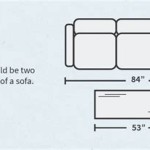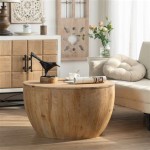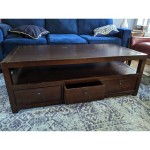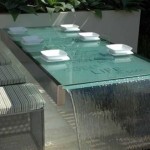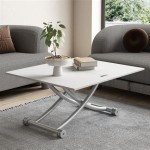Coffee Table Replacement Glass Top: A Comprehensive Guide
A coffee table is a central piece of furniture in many living rooms. It serves as a convenient surface for drinks, books, and decorative items, while also contributing to the overall aesthetic of the space. When the glass top of a coffee table breaks, chips, or becomes excessively scratched, it not only diminishes the table's visual appeal but also poses a safety hazard. Replacing the glass top is often a more cost-effective and sustainable solution than replacing the entire coffee table. This article provides a detailed guide on selecting, sourcing, and installing a replacement glass top for a coffee table.
Understanding the Need for Replacement
Several factors can necessitate the replacement of a coffee table's glass top. Accidental impacts, such as dropping heavy objects or collisions with furniture, are common causes of breakage. Over time, even without major incidents, scratches and chips can accumulate, making the glass appear worn and unsightly. Changes in temperature or humidity can occasionally cause stress fractures in the glass, leading to cracks. Furthermore, if the original glass was not properly tempered, it may be more susceptible to shattering upon impact. Replacing the glass top restores the table's functionality and improves the room's overall appearance, maintaining its design integrity.
Beyond the aesthetic considerations, a damaged glass top can present significant safety risks. Sharp edges from broken glass pose a laceration hazard, particularly for children and pets. Even minor chips and cracks can weaken the glass structure, making it more prone to further breakage under pressure. Replacing the damaged glass top with a new, properly tempered piece ensures the safety of the household and prevents potential injuries.
In situations where the coffee table frame is still in good condition, replacing only the glass top is a practical and environmentally conscious choice. Discarding the entire table would contribute to landfill waste, whereas replacing the glass allows for the continued use of the existing furniture. This sustainable approach aligns with the principles of reducing consumption and extending the lifespan of household items.
Selecting the Right Replacement Glass
Choosing the appropriate replacement glass top is crucial for ensuring both safety and aesthetic compatibility with the coffee table's design. Several factors must be considered during the selection process, including the type of glass, thickness, shape, and edge finish.
Type of Glass: Tempered glass is the standard choice for coffee table tops due to its superior strength and safety characteristics. Tempered glass is heat-treated to increase its resistance to breakage and impact. If tempered glass does break, it shatters into small, relatively harmless pieces instead of sharp shards, significantly reducing the risk of injury. Other types of glass, such as annealed glass, are generally not recommended for coffee tables due to their lower strength and the dangerous nature of their breakage patterns. Another option, although less common, is laminated glass. Laminated glass consists of two or more layers of glass bonded together with a plastic interlayer. If broken, the glass fragments adhere to the interlayer, preventing shattering and maintaining structural integrity.
Thickness: The thickness of the replacement glass is a critical factor in determining its durability and load-bearing capacity. The appropriate thickness depends on the size and shape of the coffee table, as well as the weight of items that will be placed on it. Generally, a thickness of 1/4 inch (6mm) is sufficient for smaller coffee tables with a solid base. Larger tables or those expected to hold heavier items may require a thicker glass, such as 3/8 inch (10mm) or 1/2 inch (12mm). Consulting with a glass professional can help determine the optimal thickness for a specific coffee table and its intended use.
Shape: The shape of the replacement glass should match the original glass top or complement the overall design of the coffee table. Common shapes include rectangular, square, round, and oval. Custom shapes are also possible, although they may require special ordering and fabrication. When selecting a shape, consider the table's base and the surrounding furniture to ensure a cohesive and visually appealing look.
Edge Finish: The edge finish of the glass top influences both its aesthetic appeal and safety. Several edge options are available, each with its own distinct characteristics. A flat polished edge provides a clean, modern look with a smooth, flat surface. A beveled edge features an angled cut that adds a touch of elegance and sophistication. A pencil polished edge is slightly rounded, offering a softer, more comfortable feel. A seamed edge, also known as a swiped edge, is a basic finish that removes sharp edges to prevent cuts. The choice of edge finish depends on the desired style and the overall design of the coffee table. For safety, it is recommended to select an edge finish that minimizes sharp corners and provides a smooth, comfortable surface.
Sourcing and Installing the Replacement Glass
Once the specifications for the replacement glass are determined, the next step is to source the glass and arrange for its installation. There are several options for obtaining a replacement glass top, each with its own advantages and disadvantages.
Local Glass Shops: Local glass shops are a reliable source for custom-cut glass tops. These shops typically offer a wide range of glass types, thicknesses, and edge finishes. They can also provide professional advice and assistance in selecting the appropriate glass for a specific coffee table. Working with a local glass shop allows for direct communication and personalized service. It also provides the opportunity to inspect the glass before purchase and ensures accurate measurements for a perfect fit. Many local shops offer installation services as well, further simplifying the replacement process.
Online Retailers: Numerous online retailers specialize in replacement glass tops. These retailers often offer a wider selection of sizes, shapes, and finishes than local shops. Online ordering can be convenient and time-saving, allowing for comparison shopping and access to a broader range of options. However, it is essential to carefully review the retailer's reputation, return policy, and shipping procedures before placing an order. Accurate measurements are crucial when ordering online, as returns due to incorrect sizing can be costly and inconvenient.
DIY Installation vs. Professional Installation: The decision of whether to install the replacement glass top oneself or hire a professional depends on several factors, including one's comfort level with DIY projects, the complexity of the installation, and the availability of necessary tools and equipment. Simple installations, such as replacing a glass top that rests directly on the table frame, can often be handled by homeowners with basic tools. However, more complex installations, such as those involving adhesive bonding or intricate edge fitting, may require professional expertise.
If choosing to install the glass top oneself, it is essential to take precautions to ensure safety and prevent damage to the glass or the table frame. Wear protective gloves and eye protection to avoid cuts and injuries. Carefully clean the table frame and the replacement glass before installation. Use appropriate adhesives, if required, and follow the manufacturer's instructions carefully. Avoid applying excessive pressure to the glass, which can cause it to crack or break. If unsure about any aspect of the installation process, it is best to consult with a professional.
Professional installation offers several advantages. Experienced installers have the knowledge and skills to handle glass safely and efficiently. They can also ensure a precise fit and proper adhesion, minimizing the risk of damage or future problems. While professional installation may involve additional cost, it can provide peace of mind and guarantee a high-quality result. When selecting a professional installer, it is advisable to obtain quotes from multiple sources and to check their credentials and references.
Before installing the replacement glass, ensure the table frame is clean and free of debris. If the original glass was secured with adhesive, carefully remove any residue using a scraper or solvent, following safety precautions. Verify the dimensions of the replacement glass against the table frame to ensure a proper fit. Once the glass is in place, inspect it for any imperfections or signs of stress. Regular cleaning with a glass cleaner will help maintain its clarity and appearance.

Replacement Glass Coffee Table Doctor

Did Your Tabletop Glass Break Scavenger Chic

Glass Table Top Fab And Mirror

Coffee Table Transformation Glass Makeover Furniture

A Complete Guide To Replacement Glass For Coffee Table

Fairy Tale Coffee Table Replacement Glass Stori Modern

Glass Table Top Replacement For Custom Coffee Tables Dining And More

Replace Glass Table Top Why You Have To

Coffee Table Glass Insert Replacement Collection With Panels Remove Shabby Chic Makeover

Outdoot Furniture Toughened Glass Table Top Replacement Tempered Tops Patio Made In Com

